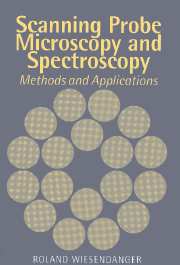Book contents
- Frontmatter
- Contents
- Preface
- List of acronyms
- Introduction
- Part one Experimental methods and theoretical background of scanning probe microscopy and spectroscopy
- 1 Scanning tunneling microscopy (STM)
- 2 Scanning force microscopy (SFM)
- 3 Related scanning probe methods
- Part two Applications of scanning probe microscopy and spectroscopy
- References
- Index
2 - Scanning force microscopy (SFM)
Published online by Cambridge University Press: 05 October 2010
- Frontmatter
- Contents
- Preface
- List of acronyms
- Introduction
- Part one Experimental methods and theoretical background of scanning probe microscopy and spectroscopy
- 1 Scanning tunneling microscopy (STM)
- 2 Scanning force microscopy (SFM)
- 3 Related scanning probe methods
- Part two Applications of scanning probe microscopy and spectroscopy
- References
- Index
Summary
We have already discussed in section 1.22 that a variety of forces act between the tip and the sample during STM operation with their strength depending on the tip–surface separation. These forces have been exploited to develop another type of scanning probe microscopy, namely scanning force microscopy (SFM), which no longer uses electron tunneling to probe local properties of sample surfaces, but rather the tip–sample force interaction. Since the force interaction does not depend on electrically conducting samples (and tips), SFM can be applied to insulators as well, thereby extending the applicability of local probe studies to an important class of materials which are difficult to investigate by electron microscopical and spectroscopical techniques due to charging problems. Before we focus on SFM, a brief historical review of surface force measurements and surface profilometry, which are closely related to SFM, is given in the next section.
Historical remarks on surface force measurements and surface profilometry
Surface force apparatus (SFA)
For two electrically neutral and non-magnetic bodies held at a distance of one to several tens of nanometers, the van der Waals (VDW) forces usually dominate the interaction force between them. The VDW forces acting between any two atoms or molecules may be separated into orientation, induction and dispersion forces. Orientation forces result from interaction between two polar molecules having permanent multipole moments, whereas induction forces are due to the interaction of a polar and a neutral molecule where the polar molecule induces polarity in the nearby neutral molecule.
- Type
- Chapter
- Information
- Scanning Probe Microscopy and SpectroscopyMethods and Applications, pp. 210 - 264Publisher: Cambridge University PressPrint publication year: 1994



